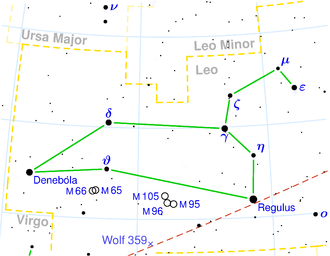NGC 3434
| Galaxy NGC 3434 |
|
|---|---|

|
|
| SDSS recording | |
| AladinLite | |
| Constellation | lion |
|
Position equinox : J2000.0 , epoch : J2000.0 |
|
| Right ascension | 10 h 51 m 58.0 s |
| declination | + 03 ° 47 ′ 31 ″ |
| Appearance | |
| Morphological type | SA (r) b / HII |
| Brightness (visual) | 12.3 mag |
| Brightness (B-band) | 13.1 mag |
| Angular expansion | 2.1 ′ × 1.9 ′ |
| Position angle | 41 ° |
| Surface brightness | 13.7 mag / arcmin² |
| Physical data | |
| Affiliation | isolated |
| Redshift | 0.012128 ± 0.000003 |
| Radial velocity | (3636 ± 1) km / s |
|
Stroke distance v rad / H 0 |
(157 ± 11) · 10 6 ly (48.1 ± 3.4) Mpc |
| history | |
| discovery | Wilhelm Herschel |
| Discovery date | January 27, 1786 |
| Catalog names | |
| NGC 3434 • UGC 5980 • PGC 32595 • CGCG 038-036 • MCG + 01-28-015 • 2MASX J10515804 + 0347312 • GC 2241 • H III 497 • h 784 • HIPASS J1051 + 03b • SIP 102-1 | |
NGC 3434 is a spiral galaxy with extensive star formation regions of the Hubble type Sb in the constellation Leo on the ecliptic . It is estimated to be 157 million light years from the Milky Way and about 100,000 light years across.
The object was discovered on January 27, 1786 by the astronomer Wilhelm Herschel .
